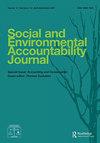可视化作为绿色清洗:英国石油公司和深水地平线的案例
Q2 Business, Management and Accounting
Social and Environmental Accountability Journal
Pub Date : 2020-10-27
DOI:10.1080/0969160X.2020.1837416
引用次数: 1
摘要
图像和视觉在构建和塑造现实中所起的作用是本文的重点。本文探讨了视觉作为叙事模式如何在组织环境中战略性地使用。特别是,通过关注英国石油公司及其在2010年深水地平线事件后对图像和视觉效果的使用,本文展示了视觉图像的使用是多么强大,图像和洗绿:权力意味着“通过视觉和图像创造、转换或稳定现实的特定‘版本’”,该公司因深水地平线事件受到指控(16);洗绿被视为一种象征性的战略行动,它积极主动地制定与利益相关者的沟通框架。有选择地披露信息可能是利益相关者越来越关注的结果,特别是在公司发生灾难后出现的情况下。视觉和图像是绿色清洗的组成部分,对组织的构建和描述有不同的影响。本研究采用视觉社会符号学方法分析英国石油公司的网站(从2006年到2014年),特别关注追踪i)网站结构、ii)颜色和符号以及iii)照片的变化。研究结果分三个不同时期进行讨论;i) 灾前叙事,其中图像被用来揭露“新的”和“给定的”信息,ii)灾后叙事,显示信息在“理想的”与“真实的”之间传播,以及iii)具有混合结构的叙事过渡期。使用图像和视觉构建的叙事有助于讲述一个故事(或不同的故事)、影响和影响、决策以及公司利益相关者的信任。本案关注的是图像和视觉在增强企业索赔和消除“洗绿”指控方面的力量。视觉和图像可以增强公司的合法性,从这个意义上说,通过开发使用图像和视觉的复杂方法,洗绿活动可以变得更加强大。英国石油公司的案例适合描述在灾后环境中,网站图像如何将注意力从灾难转移到更复杂的现实表现形式,从而帮助转移网站读者的注意力。作者建议,进一步的研究可以考虑用户对洗绿行为的反应和态度,重点关注可能的多种解释。对Flickr、Twitter、Facebook和Instagram等新社交媒体的作用进行深入分析,对于考虑视觉效果和图像如何在考虑图像和视觉效果读者参与的动态沟通相互作用中塑造组织叙事也很重要。进一步的研究建议包括在意义创造的维度上,使用网站上的视觉和图像,对社会结构有更深入的理解。本文章由计算机程序翻译,如有差异,请以英文原文为准。
Visuality as Greenwashing: The Case of BP and Deepwater Horizon
The role that images and visuals play in constructing and shaping reality is the focus of this paper. The paper explores how visuals as modes of narration can be used strategically in the organisational context. In particular, by focusing on BP and their use of images and visuals following from the 2010 Deepwater Horizon incident, the paper displays how powerful the use of visual imagery can be. Central to the paper are the notions of power of visuals, images and greenwashing: power means “to create, transform, or stabilise particular ‘versions’ of reality through visuals and images” used after the Deepwater Horizon incident for which the company is accused (16); greenwashing is seen as a symbolic strategic action that operates, proactively, in framing communications to stakeholders Disclosing information selectively can occur as a result of the increased attention of stakeholders, specifically in the case presented, after a disaster in which the company is involved. Visuals and images are an integral part of greenwashing and have different effects on constructing and describing the organisation. A visual socio-semiotic approach is adopted in this study to analyse the website of BP (from 2006 to 2014), specifically focusing on tracing changes in i) the structure of the website, ii) in colours and symbols, and iii) photographs. Findings are discussed in three distinct periods; i) a pre-disaster narrative, where images are used to expose “new” and “given” information, ii) a post-disaster narrative, that shows information spread between “ideal” and “real”, and iii) a transition period of narratives with a mixed structure. The narratives constructed, using images and visuals, help tell a story (or different stories), affect and influencememorability, decision-making and trust of stakeholders in the company. The case focuses on the power of the images and visuals in enhancing the corporate claims and dispelling greenwashing accusations. Visuals and images can enhance the legitimacy of the company, and in this sense activities of greenwashing can become more powerful by developing sophisticated methods to use images and visuals. The BP case is suitable in describing how in a post-disaster setting, website images act as a way of diverting attention from a catastrophe, towards more sophisticated forms of representing reality, that help in shifting the attention of the readers of the website. The authors suggest that further research could consider the responses and attitudes of users to greenwashing practises, with a focus on the multiplicity of possible interpretations. In-depth analyses on the role of new social media, such as Flickr, Twitter, Facebook and Instagram could also be important in considering how visuals and images shape the organisational narratives in an interplay of dynamic communication that considers the involvement of the readers of images and visuals. Further suggestions for research include deeper understandings of social construction, in the dimension of meaning-making, using visuals and images on websites.
求助全文
通过发布文献求助,成功后即可免费获取论文全文。
去求助
来源期刊

Social and Environmental Accountability Journal
Business, Management and Accounting-Accounting
CiteScore
3.90
自引率
0.00%
发文量
16
期刊介绍:
Social and Environmental Accountability Journal (SEAJ) is the official Journal of The Centre for Social and Environmental Accounting Research. It is a predominantly refereed Journal committed to the creation of a new academic literature in the broad field of social, environmental and sustainable development accounting, accountability, reporting and auditing. The Journal provides a forum for a wide range of different forms of academic and academic-related communications whose aim is to balance honesty and scholarly rigour with directness, clarity, policy-relevance and novelty. SEAJ welcomes all contributions that fulfil the criteria of the journal, including empirical papers, review papers and essays, manuscripts reporting or proposing engagement, commentaries and polemics, and reviews of articles or books. A key feature of SEAJ is that papers are shorter than the word length typically anticipated in academic journals in the social sciences. A clearer breakdown of the proposed word length for each type of paper in SEAJ can be found here.
 求助内容:
求助内容: 应助结果提醒方式:
应助结果提醒方式:


